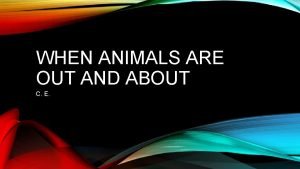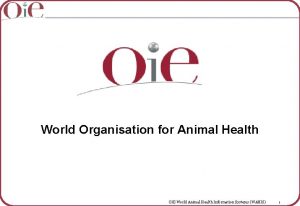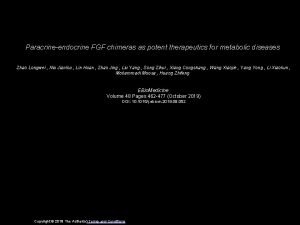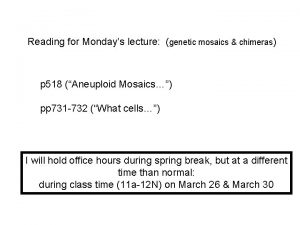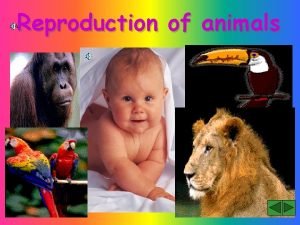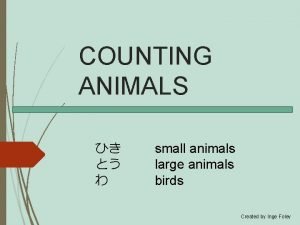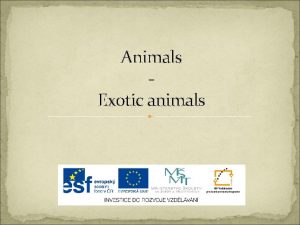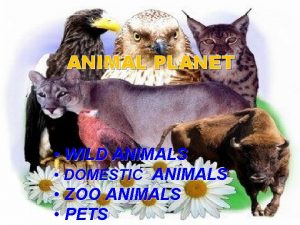Chimeric Animals What are Chimeras Chimeras are animals












- Slides: 12

Chimeric Animals

What are Chimeras? • Chimeras are animals composed of cells that originate from two (or more) different species. • In the research lab, chimeras are created by introducing cells from one species into the developing embryo or fetus of another. • The name chimera comes from Greek mythology and describes a creature with the head of a lion, the body of a goat, and the tail of a serpent.


A sheep-goat chimera, created in 1984, had the head of a goat and the woolly coat of a sheep.

Chimeras, Mosaics, Hybrids • Chimeras are different from mosaics- organisms that contain genetically different populations of cells originating from a single zygote. • Chimeras are different from hybrids too, which are organisms containing genetically identical populations of cells originating from a cross of two different species.

Dispermic Chimeras • Two eggs that have been fertilized by two sperm fuse together, producing a so-called tetragametic individual—an individual originating from four gametes. • The different tissues of tetragametic chimeras are made up of cells derived from one or both zygotes. • Indications of tetragametic chimerism include eyes differing in colour, patchwork skin coloration, and ambiguous external genitalia, which is a sign of hermaphroditism (having both male and female reproductive organs). • In most instances, however, there are no observable symptoms of tetragametic chimerism, and the condition is detected only through extensive genetic analysis

Twin Chimeras • When two zygotes do not undergo fusion but exchange cells and genetic material during development, two individuals called twin chimeras, are produced. • one or both of them contain two genetically distinct cell populations. • The most widely known examples of twin chimerism are blood chimeras. • Blood Chimeras are produced when blood anastomoses (connections) form between the placentas of dizygotic twins, thereby enabling the transfer of stem cells between the developing embryos. • When blood chimerism involves male and female twins, female exposure to male hormones results in freemartin syndrome, in which the female is masculinized; this is commonly seen in cattle and rarely in humans.

Other Types of Chimeras • Microchimeras are produced when fetal stem cells or maternal cells cross the placenta or following blood transfusion or organ transplantation. • Parthenogenetic Chimeras be produced when a fertilized egg generated through parthenogenesis fuses with a normal zygote. • Androgenetic Chimeras are made up of cells that contain the normal combination of maternal and paternal chromosomes and cells that contain two sets of paternal chromosomes (paternal isodisomy). – Mammalian androgenetic chimeras generated experimentally rarely survive to birth – In humans, the condition can occur naturally, though it typically ends in embryonic death.

Mouse Embryonic Chimeras

Major Projects Underway Utilizing Human. Animal Chimeras • At the University of Nevada, researchers have added human stem cells to sheep fetuses to create chimeras. Some sheep now have livers with up to 80% human cells that produce the compounds normally made by human livers. • Mayo Clinic researchers in Minnesota are studying how speciallybred pigs could be used as sources of organs for human transplant patients. They have developed a line of pigs that have pig blood cells, human blood cells, and a new kind of blood cells with characteristics of both humans and pigs. • At St. Kitts Biomedical Foundation in the Caribbean, scientists are transplanting immature human brain cells deep into the brains of vervet monkeys. Their goal is to develop a treatment for Parkinson’s disease


THANKS
 Insidan region jh
Insidan region jh Animals that eat both plants and animals
Animals that eat both plants and animals Kyle douglass
Kyle douglass Consumers producers and decomposers
Consumers producers and decomposers Parasitic food chain
Parasitic food chain Ce animals
Ce animals Animal clues what am i
Animal clues what am i Animals vertebrats
Animals vertebrats Section 26-1 introduction to the animal kingdom
Section 26-1 introduction to the animal kingdom Carroll diagram animals
Carroll diagram animals Homeostasis in animals examples
Homeostasis in animals examples Is porifera exclusively marine
Is porifera exclusively marine Wahis oie
Wahis oie





